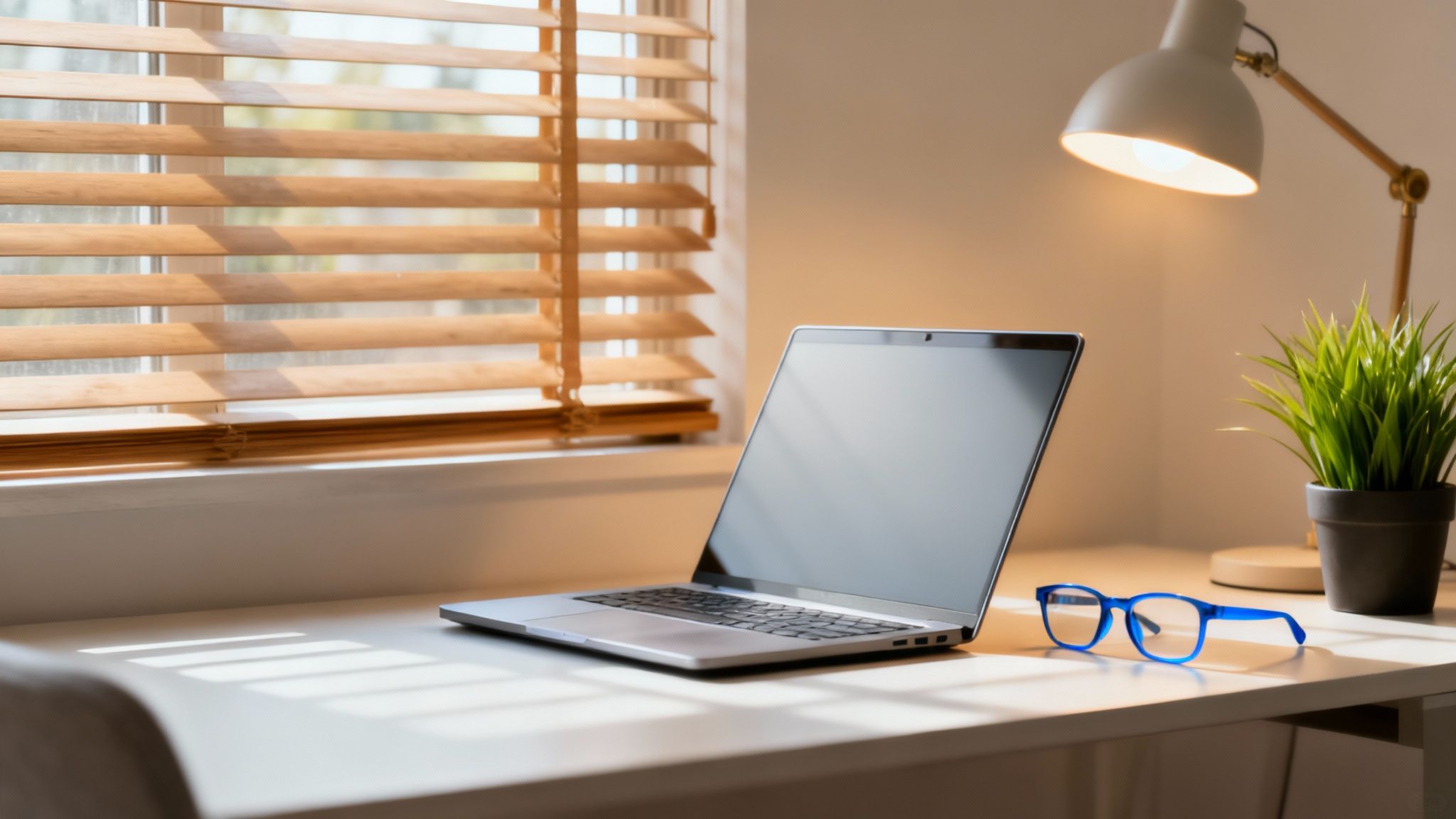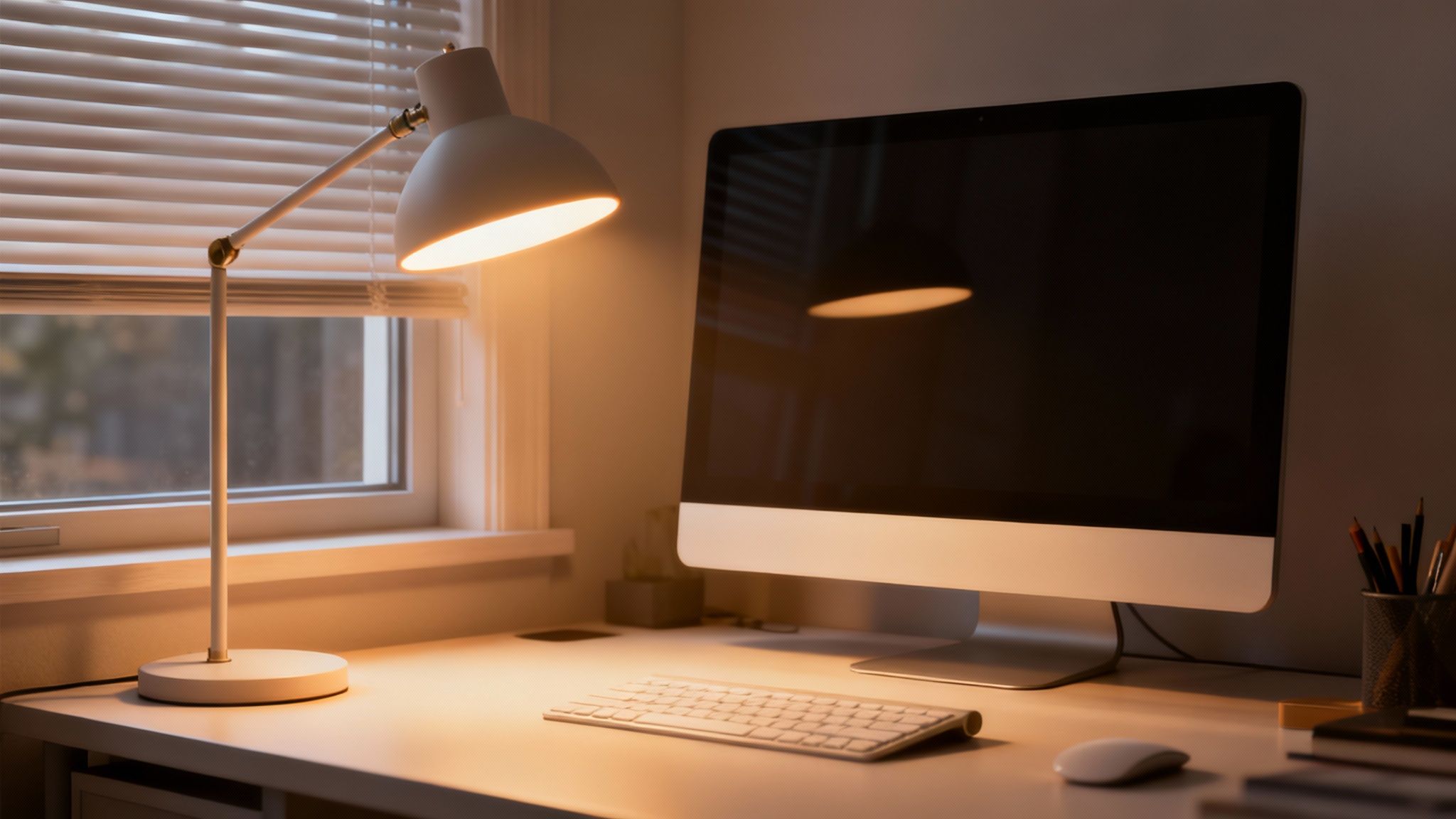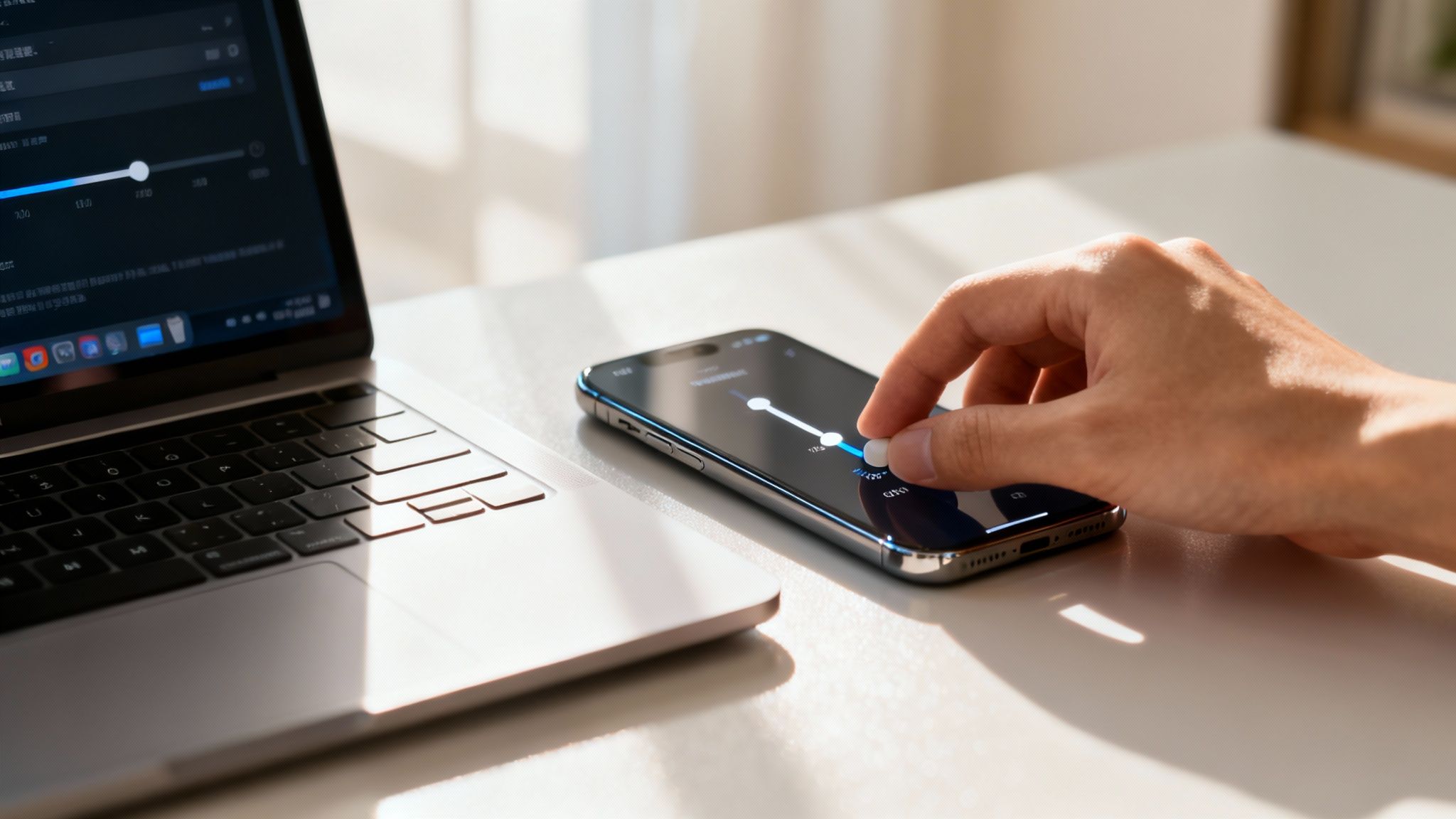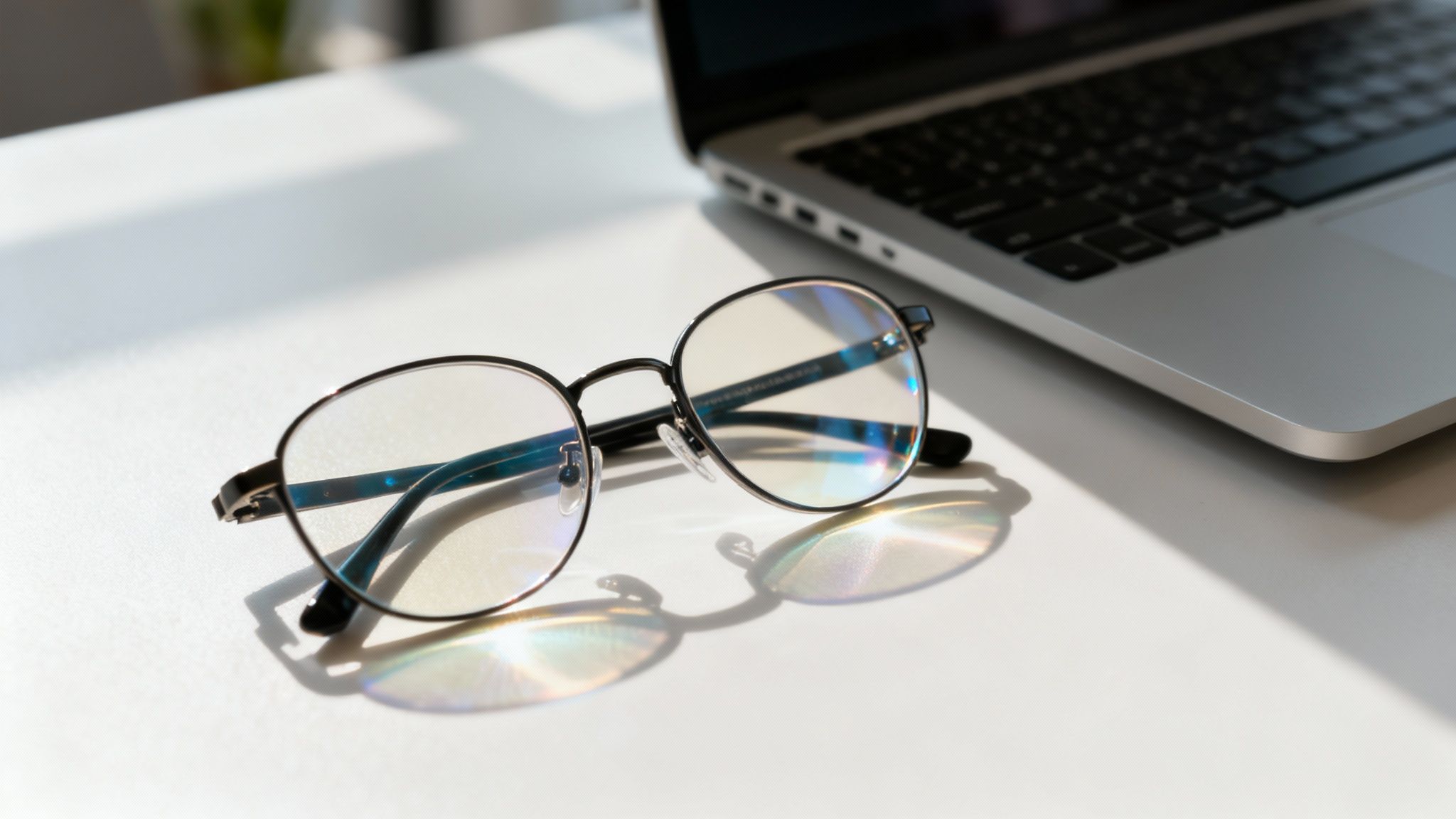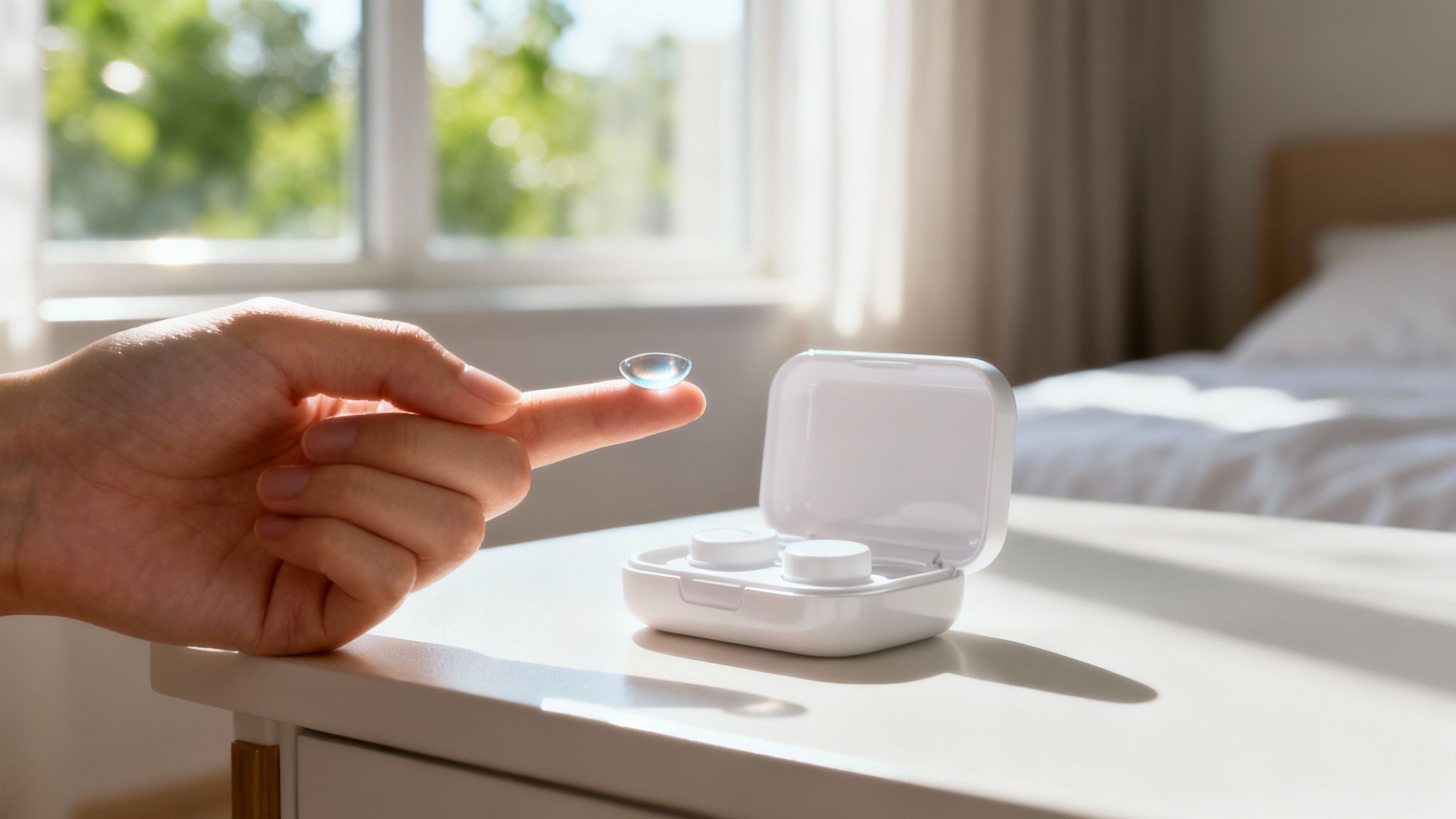If you've ever found yourself squinting at your monitor, trying to see past your own reflection, you know how frustrating screen glare can be. It's a leading cause of digital eye strain, and frankly, it's a productivity killer. But you don't have to put up with it. For residents of Glendale Heights and the surrounding Chicagoland suburbs, finding relief is crucial for both work and daily life.
Tackling screen glare effectively isn't about one magic fix. It’s about a smart, three-pronged attack: tweaking your workspace, dialing in your device settings, and finally, using the right gear to protect your eyes. It's a simple formula that offers immediate relief.
Your Guide to Winning the Battle Against Screen Glare
That tired, achy feeling in your eyes after a long day in front of a computer is something most of us know all too well. It's a shared experience, whether you're a student at Glenbard West High School cramming for exams or a professional working from a home office near Glendale Lakes Golf Club. Here in Glendale Heights, digital eye strain is a part of daily life.
This guide is designed to give you practical, no-nonsense strategies you can use right away. We'll walk through everything from easy adjustments you can make to your environment to eyewear solutions that can genuinely change your day-to-day comfort. At iDoctor, our warm and professional team is dedicated to helping you find clear, comfortable vision.
A Three-Step Approach to Clearer Vision
Getting rid of screen glare doesn't need to be a huge, complicated project. It really boils down to making a few key changes in your workspace, on your devices, and with your personal eyewear.
This visual guide breaks it all down into three straightforward, actionable steps.
This process really highlights why a combined approach is king. You need to address your physical space, the technology you're using, and your own vision correction to truly beat digital eye strain. Each step supports the others, creating a much more comfortable and sustainable viewing experience.
The most powerful strategy for reducing screen glare involves layering solutions. You can’t just buy anti-glare glasses and expect them to solve the problem if you're sitting with a bright window directly behind you.
Here’s a quick overview of the most effective methods you can use right now to fight screen glare and find immediate relief.
Three Quick Ways to Reduce Screen Glare
| Strategy Area | Key Action | Primary Benefit |
|---|---|---|
| Workspace Setup | Position your screen away from direct light sources (windows, overhead lights). | Minimizes direct reflections on your screen. |
| Device Settings | Increase brightness to match ambient light and use a matte screen protector. | Reduces the mirror-like effect of a glossy screen. |
| Protective Eyewear | Wear glasses with an anti-reflective (AR) coating. | Filters out distracting glare before it reaches your eyes. |
By combining these tactics, you create multiple layers of defense against eye strain, which is far more effective than relying on a single solution.
For those of us in and around Glendale Heights, putting these changes into practice can make a world of difference. Maybe you just need to rearrange your desk, or perhaps it's time to consider upgrading to designer eyeglasses with a quality anti-reflective coating. At iDoctor, our team can help with that final, crucial step—making sure your eyewear is perfectly matched to your digital life. You can start by scheduling one of our detailed eye exams in Glendale Heights to get a truly personalized recommendation.
Arranging Your Workspace to Beat Reflections
Before you even think about diving into device settings or buying special glasses, your first and most powerful tool against screen glare is your own environment. You'd be surprised how much you can improve things just by making a few simple, no-cost tweaks to your workspace. The real secret is to control the light sources around you, not to fight a losing battle against them.
Think of your screen as a mirror for a second. If there's a bright window or a harsh overhead lamp directly behind you, what happens? Its reflection stares right back at you. It’s a common frustration, especially for those of us working from makeshift home offices in Glendale Heights. Luckily, the fix is often just a matter of moving your desk.
Strategic Screen Placement
Here’s the golden rule: position your screen perpendicular to the main light source. This means any windows should be to your side, not directly in front of you or behind you. This one move stops light from either blasting into your eyes or bouncing off the screen.
For instance, if you have a big, sunny window on one wall, arrange your desk so that window is on your left or right as you face your monitor. I can't overstate how much of a difference this simple change makes.
Pro-Tip: Remember that the sun moves. A setup that’s perfect in the morning might be a glare-filled nightmare by 3 PM. Get in the habit of adjusting your blinds or curtains throughout the day to keep up.
Don't forget about the lights inside the room, either. Those harsh, buzzing overhead fluorescent lights are notorious for causing screen glare. If you can't get rid of the fixture, just turn it off. Instead, use a desk lamp with a warm bulb and a good shade. This gives you a softer, indirect light that won’t create those distracting reflections.
Managing Your Windows and Lighting
Getting a handle on natural light is key. While we all love a bit of sunshine, it can be a real enemy to screen visibility. When the sun is at its brightest, the easiest thing you can do is just close the blinds or curtains.
- Blinds: These are fantastic because they give you precise control. You can angle them just right to block the direct sun while still letting in some ambient light.
- Curtains: If glare is a constant headache, it might be time to invest in heavier curtains. You can really dial in your light control by choosing between room darkening vs blackout curtains depending on how intense the problem is.
Making these small adjustments to your space creates the foundation for a much more comfortable viewing experience. Once you get your environment sorted out, any changes you make to your device settings or eyewear will be that much more effective.
Using Your Device Settings for Better Visual Comfort
Once your physical workspace is sorted, your next best tool is right in your hands—the device itself. Your phone, tablet, and computer are packed with built-in features designed to take the edge off harsh screen light, which is often the culprit behind eye strain and headaches. The best part? These adjustments are free and only take a moment to change.
Let’s start with the most basic one: screen brightness. A good rule of thumb is to think of your screen as a chameleon, not a light bulb. It should blend in with the light around you. If you're working in a dimly lit coffee shop, dial the brightness down. In a bright, sunlit office? Crank it up a bit. This simple habit keeps your eyes from constantly struggling to adjust between two competing light sources.
Fine-Tuning Your Display for Clarity
Beyond just brightness, you can dig a little deeper into your display settings for even more relief. Bumping up the text contrast, for example, makes words pop off the screen. This makes reading feel less like a chore for your eyes.
Another feature I personally can't live without is Dark Mode. Switching from a bright white background to a dark one with light text dramatically cuts down on the amount of light hitting your eyes. It’s particularly useful in the evening when your eyes are already winding down.
Key Takeaway: Settings like Dark Mode and Night Shift do more than just fight glare. They also reduce your exposure to the high-energy blue light that can mess with your sleep. Making these adjustments a part of your daily routine is a huge step toward better digital wellness.
Most devices also have a feature called "Night Light" or "Night Shift." This shifts the screen's color palette toward warmer, yellowish tones, filtering out that stimulating blue light. Combining these software tweaks is a powerful way to combat eye fatigue. For an even deeper dive, our guide on how to prevent computer eye strain has more great tips.
The Rise of Built-In Anti-Glare Technology
It’s not just us—device manufacturers are paying attention, too. Screens with built-in anti-glare technology are becoming standard. In North America alone, the anti-glare display market was valued at around USD 3.2 billion and is projected to hit USD 4.5 billion by 2035. This boom is driven by our demand for displays that cut down on reflections right out of the box. You can see the full breakdown in the anti-glare display market report from WiseGuyReports.com.
So, when you're ready for an upgrade, keep an eye out for devices with a matte screen finish. Glossy screens are notorious for acting like mirrors, reflecting every light source in the room. Matte displays, on the other hand, are engineered to scatter light, which naturally minimizes glare from the get-go. For anyone who spends hours a day staring at a screen, they’re a much better choice.
How Anti-Glare Screen Protectors Can Help
If your device has a glossy screen that seems to double as a mirror, an anti-glare screen protector can be a lifesaver. These aren't just flimsy pieces of plastic; they have a specialized matte finish designed to diffuse harsh light. Instead of a bright light source reflecting directly back at you, the protector scatters it, cutting down that distracting glare in a big way.
This makes it an ideal, budget-friendly fix for anyone who can't fully control their lighting. I'm talking about students trying to study under the bright lights at the College of DuPage library, or professionals in a coworking space with annoying overhead fluorescent bulbs. It's a simple upgrade that pays huge dividends in visual comfort.
Choosing the Right Protector for Your Device
When you start shopping around, you'll see a dizzying number of options. The real trick is finding a high-quality protector that doesn't mess with your screen's clarity or touch sensitivity. A cheap, poorly made film can make your beautiful high-resolution display look fuzzy or grainy, which completely defeats the purpose.
So, what should you look for?
- Matte Finish: Make sure the packaging specifically says "anti-glare" or "matte." This is the key ingredient that tackles reflections.
- High Transparency: Good protectors will advertise high clarity, often rated at 95% or higher. This ensures you don't get a blurry image.
- Case Compatibility: Check that the protector is "case-friendly." You don't want the edges of your phone case to peel it right off.
The best anti-glare protector is one you forget is even there. You just notice that the glare is gone. For anyone who spends hours on their device, it's an immediate quality-of-life improvement.
More Than Just a Niche Product
This is no longer just a minor accessory; it’s a massive market fueled by our ever-increasing screen time and a growing concern for eye health. The global market for anti-glare laptop screen protectors recently hit about USD 1.79 billion. It’s expected to climb to around USD 2.58 billion by 2029.
That kind of growth tells a story—it reflects the huge number of people now working remotely and staring at screens for hours on end. You can read the full research on the anti-glare screen protector market if you want to see just how much demand has exploded.
While screen protectors are fantastic for your devices, they are only one part of the solution. They're most effective when you combine them with other strategies, like fixing your room's lighting and, crucially, wearing the right eyewear. For a truly comprehensive approach, it helps to understand how anti-reflective coatings on glasses work. We break down the differences and benefits in our guide on what anti-glare on glasses does. This layered strategy—protecting both your screen and your eyes—is the best defense against digital eye strain.
Choosing the Right Eyewear for Your Screen Time
While tweaking your environment and device settings are great first steps, your best defense against screen glare is often the one you wear on your face. The right pair of glasses offers a personalized shield, giving you consistent, go-anywhere relief from eye-straining reflections.
For anyone who spends a good chunk of their day staring at a screen, this is where the real magic happens. Modern lens enhancements can actively cancel out the reflections that lead to tired eyes and headaches, making for a much clearer and more comfortable view.
The Power of an Anti-Reflective Coating
An anti-reflective (AR) coating is a game-changer. It’s a very thin, multi-layered coating applied to your lenses that’s specifically engineered to stop light from bouncing off both the front and back surfaces.
This does two incredible things. First, it allows more light to pass directly through the lens, giving you sharper and more vibrant vision. Second, it practically erases those annoying reflections of overhead lights, windows, and even your own eyes that you see on your lenses. The end result is less visual clutter and a massive reduction in eye strain.
For so many of our Glendale Heights patients, simply adding an AR coating is the single most effective upgrade they make for their digital lives. It provides immediate, noticeable relief that screen protectors and room adjustments just can't fully replicate.
The need for solutions like this is booming. As our collective screen time keeps climbing, the demand for anti-glare products has exploded, with the market valued at USD 1.2 billion in a recent year and projected to double by 2032. This just goes to show how many people are feeling the effects of digital eye strain and are actively looking for help. You can discover more insights about the anti-glare market from archivemarketresearch.com.
Adding Blue Light Filtering for Extra Comfort
Beyond just tackling reflections, it’s also worth looking into blue light filtering lenses. These lenses are built to reduce your exposure to a specific slice of the light spectrum—high-energy visible (HEV) light—that our digital screens emit in spades.
While the long-term science is still being sorted out, countless people find these lenses make a real difference in how their eyes feel after a long day of computer work.
Pairing a blue light filter with an AR coating is a powerful one-two punch for anyone working in a modern office or from home. It’s an approach that tackles both the external glare bouncing off your glasses and the specific type of light coming from your screen. If you're curious about what makes the most sense for you, you should check out our guide on choosing prescription lenses for digital lifestyles in Glendale Heights.
At iDoctor, we sit down with you to find the perfect solution for your eyes and your lifestyle. We can add a premium AR coating to almost any prescription and help you explore our curated collection of designer eyeglasses in Glendale Heights. Whether you love the classic look of Tom Ford, the unmatched luxury of Cartier, or the timeless style of Ray-Ban, you never have to choose between looking great and feeling comfortable.
Little Habits, Big Impact
Once you’ve dialed in your setup and gear, the next layer of defense against eye strain comes from your daily habits. It's the small, consistent things you do that often make the most significant difference, supporting all the other changes you've made.
One of the best-known and most effective tricks in the book is the 20-20-20 rule. It's incredibly simple to put into practice. Every 20 minutes you're glued to a screen, just shift your gaze and look at something at least 20 feet away for 20 seconds. That's all it takes to give your focusing muscles a break and let them relax.
Tune Into Your Body's Needs
Have you ever noticed how dry your eyes feel after a long work session? That's because we tend to forget to blink. When we’re concentrating on a screen, our blink rate can plummet by more than 50%, leaving our eyes feeling gritty and irritated. Making a conscious effort to blink fully and often is a game-changer for keeping them moist.
Speaking of moisture, don't underestimate the power of staying hydrated. Drinking enough water helps your body produce high-quality tears, which are essential for keeping your eyes comfortable and protected.
The goal here isn't a quick fix, but a sustainable routine. Think of the 20-20-20 rule, mindful blinking, and proper hydration as your personal trifecta for long-term eye health.
Finally, take a quick look at your posture. Your screen should be about an arm's length away from your face, with the top of the monitor sitting at or just below your eye level. This simple ergonomic adjustment does wonders for preventing neck strain and keeps you from hunching forward. After a long day, especially for anyone commuting down Bloomingdale Road, you'll feel the difference.
Folding these habits into your daily life doesn’t require a massive overhaul, but the payoff for your eyes is huge. If you're looking for even more ways to keep your eyes feeling fresh, check out our detailed guide on eye exercises for eye strain.
Your Questions About Screen Glare Answered
As the best optometrist in Glendale Heights, we hear a lot of questions about screen glare. Here are a few common ones.
Is an anti-glare screen protector enough to stop eye strain?
While an anti-glare screen protector is a great tool, it’s usually not enough on its own. It only addresses the reflections on your screen. True relief comes from a layered approach: adjusting your room lighting, optimizing your device settings, and wearing the right eyewear. An anti-reflective coating on your glasses protects your eyes from all sources of glare, not just your screen.
Can I get anti-glare coatings on my favorite designer frames?
Absolutely. You don't have to sacrifice style for comfort. We can fit high-performance, anti-reflective lenses into almost any frame, including our luxury collections from Cartier, Tom Ford, and Gucci, as well as affordable brands like Michael Kors and Coach. We believe you should have both.
Will my vision insurance cover anti-glare lenses?
Most likely, yes. At iDoctor, we accept all major vision insurance plans, and many of them offer coverage for lens enhancements like anti-reflective coatings. Our approachable team can walk you through your benefits to make sure you get the best possible value for your vision.
What are the best glasses for computer glare?
The best glasses for computer glare are those with an anti-reflective (AR) coating. This specialized coating minimizes reflections from light sources hitting your lenses, which significantly reduces eye strain. For even greater comfort, you can combine an AR coating with blue light filtering lenses. We can help you find the perfect pair, whether you're looking for Fendi glasses near me or another of our curated brands.
Your vision is too precious to ignore. Here at iDoctor, we’re focused on finding personalized solutions that fit your digital life, right here in Glendale Heights. Schedule your comprehensive eye exam today.

